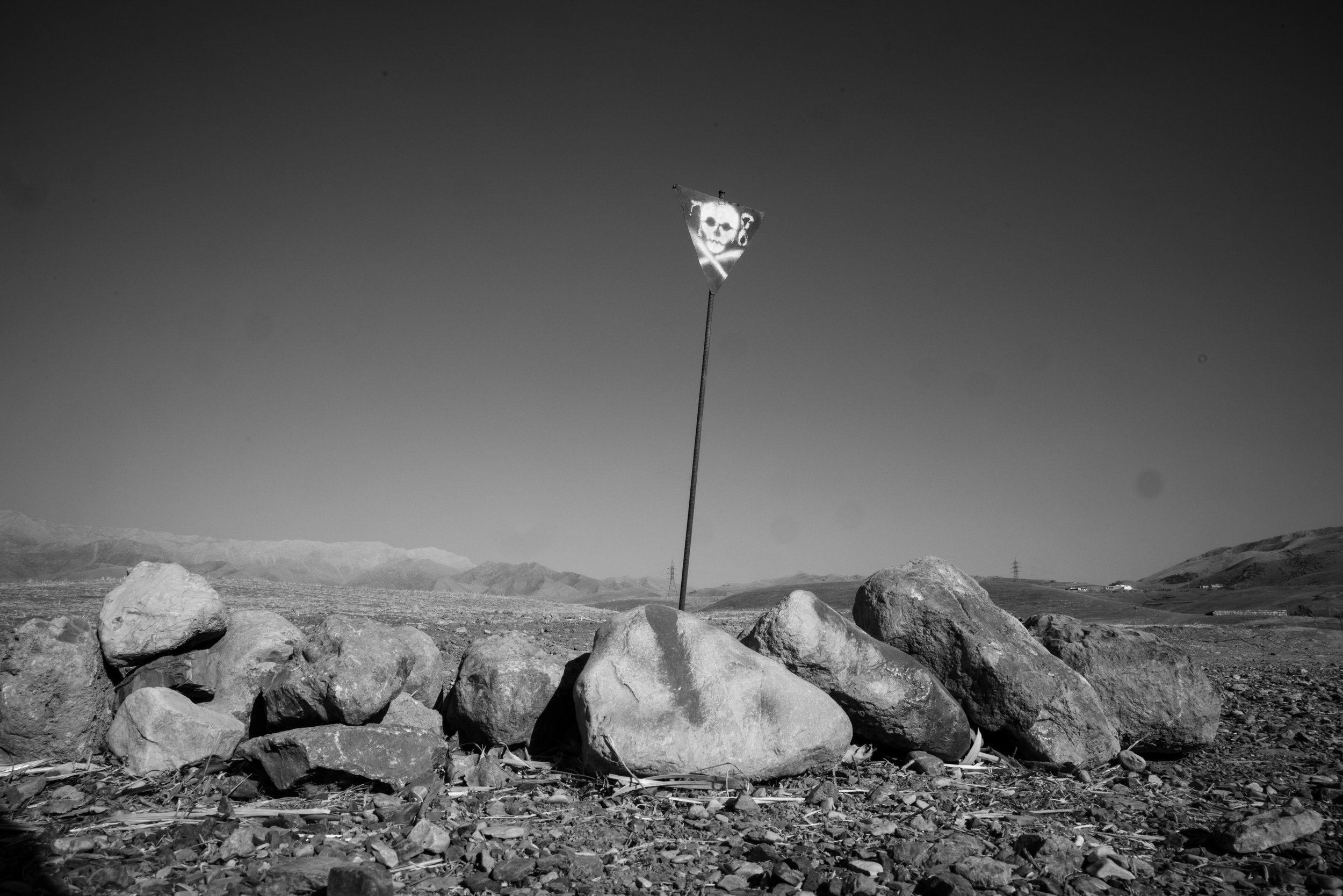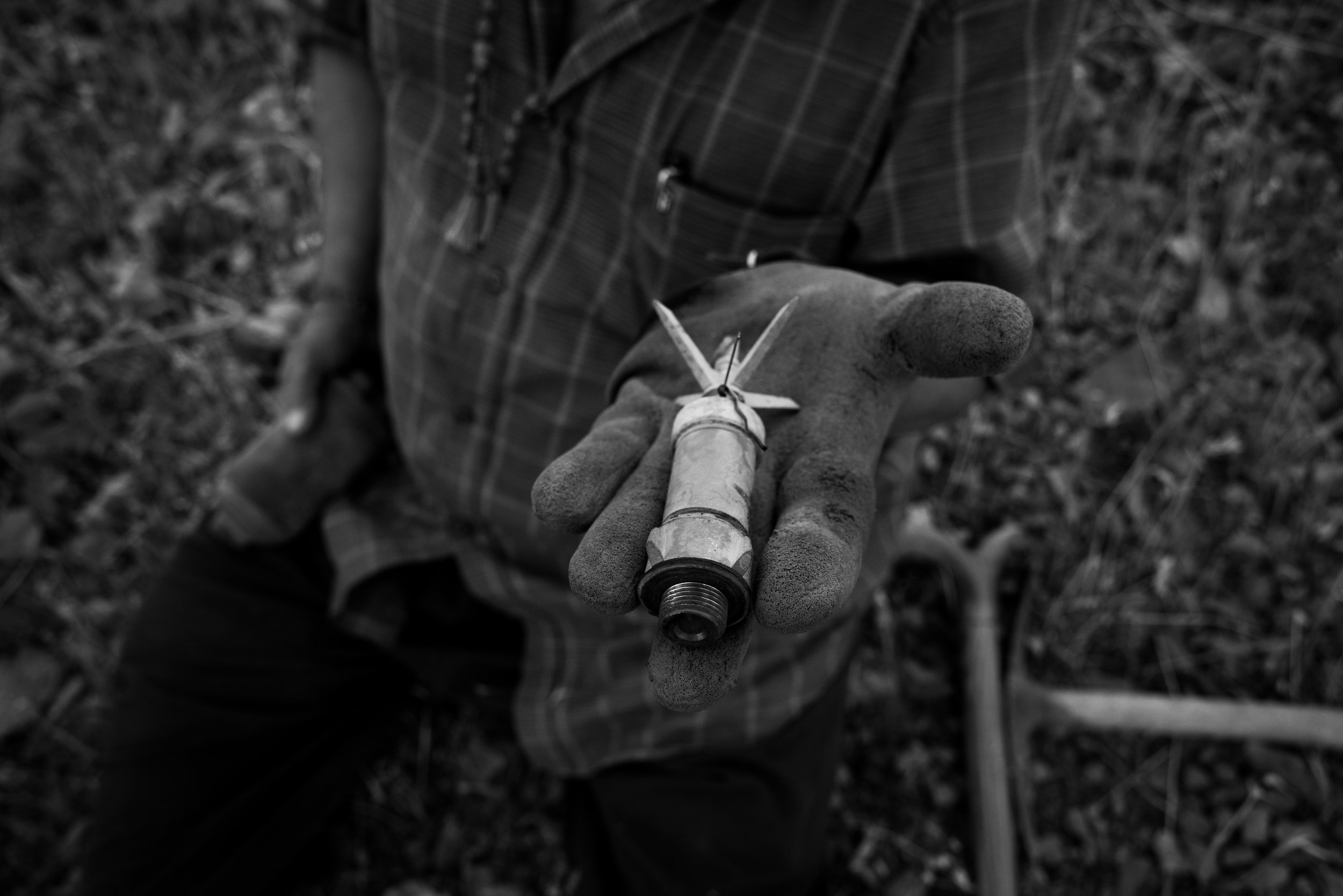
Houshyar Ali, 58, has spent the last 37 years tirelessly combing the Zargos mountain range along the Iranian border with Iraqi Kurdistan in search of landmines. A one-man show, he finds, excavates and disarms the weapons before bringing them to his home in Halabja to add to the extensive collection of once-lethal explosives lining his living room floor. Anywhere he goes, villagers offer him free food and invite him to have tea in their homes; Peshmerga-manned checkpoints let him pass in his Hyndai crossover SUV laden with photos of landmines on the doors and with a trunk full of explosives, no questions asked. In Eastern Kurdistan, where its estimated over 13,000 have been killed or injured by landmines since the 1990s, people applaud the work Houshyar has devoted his life to.
As a young adult, Houshyar became a Peshmerga with the Patriotic Union of Kurdistan (PUK), one of the political parties of Iraqi Kurdistan. It was there he first learned the trade of demining and quickly realized he had a knack for it. Over the last three decades, two accidental detonations cost Houshyar both of his legs. But to him, the incidents were just bad luck.
“Losing a leg is like being dealt a bad hand in cards, it is not in your control,” Houshyar said. “If you lose your hands and eyes, that means you made a mistake and did something incorrect.”
Houshyar’s strategy in the field is less methodical than some of NGOs focused on demining efforts, like MAG International or The HALO Trust, instead he dives in with a much more cavalier approach. Houshyar walks on his two prosthetic legs, holding a cane in one hand and a minesweeper, a specialized metal detector, in the other. He doesn't mark the areas he has already cleared or wear any sort of protective kevlar armor. When a beep from the minesweeper signals metal beneath the surface he drops his gear, lies on the ground and begins haphazardly excavating with a small pickaxe. Once uncovered, he’ll do his best to defuse the mine, but if he is unable to, he’ll leave it on a small pile of stones and return to it another day. When he encounters the VS-50, a small Iranian mine, he unscrews its two plastic halves by hand then bites off its small neoprene pressure pad, exposing the device’s detonator.
He claims to have disarmed or deemed safe over 2 million mines and pieces of ordinance which include discovering immense caches over the years. Houshyar has rescued over 100 people stranded in mine fields and even a herd of cattle.
His favorite mines to find and diffuse are the Iranian variants of the VS-50 anti-personnel mine because they are the simplest. The Valmara-69, an Italian bounding mine, is the worst. “The exposed ones, or the Russian mines are easy. They are safe, but the Valmara, I see the death when I have to work with them,” Houshyar said.
The people of Eastern Kurdistan idolize Houshyar for the work he has done to clear the region of mines. There are posters of him hanging in gas stations and in schools. While driving around the area, he is often waved down or stopped by locals who thank him for all that he has done. There is a police station, school, mosque and a small village called Houshyari, named after him. He seems to enjoy in the attention. Above the diffused mines that line his living room floor, large posters of Houshyar working on mines over the years cover his walls. His exploits are immortalized in the dozens of videos he has saved to a small thumb drive. One video, taken by a Peshmerga, shows Houshyar narrowly escaping a clash with ISIS in the city of Kirkuk.
As he drives through the countless checkpoints in the region, Peshmerga approach Houshyar’s car with familiar grins – knowing exactly who he is. They peek through the windows to the trunk filled with explosives and thank Houshyar for his work that day, even shaking his hand and wishing him well. He’s likely one of few able to transport explosives unchecked through the checkpoints. Houshyar has been given free passage onto military roads along the Iranian border in order to conduct his sweeps.
But in the vast network of neighbors that embrace Houshyar, many members of own family are unfortunately not among them. A dire reality for many in Eastern Kurdistan, Houshyar himself is no stranger to loss. His parents both died following Iraqi leader Saddam Hussein’s Baathist chemical attack in Halabja on March 16, 1988, an event now internationally regarded as a genocidal massacre against the Kurdish people. They both succumbed to the toxic effects of mustard gas the morning after the attack, on March 17. Houshyar has the date tattooed on his inner forearm in remembrance. His eldest son died in a car accident on his way from working in the minefields. His brother died while demining. Houshyar’s brother and son are buried in a graveyard next to two marked graves for his legs outside of his village, north of Halabja.
Despite what he has already accomplished, and lost, Houshyar said he plans to continue the work of clearing landmines in Eastern Kurdistan for the rest of his life.
Houshyar wrestles to remove the fuse from a Yugoslavian PROM-1 landmine on a hillside along the Iranian border east of Tawella in Kurdistan.
A sign used for marking live minefields is used as decoration next to Houshyar's property outside of Halabja.
Houshyar begins to dislodge a Yugoslovian PROM-1 landmine from the ground after sliding a bobby pin through the main stem, making it more stable in order to move the mine.
A wide variety of Italian, Yugoslavian, American and Iranian mines line the floor in the living room of his home in Halabja, an explosive conversation starter for any first time guests. While the detonators have been removed the explosives remain active.
An Iraqi Border Guard points out the direction of an area contaminated with landmines along the border with Iran southeast of Tawella.
The mountainous landscape along the border east of Tawella in Kurdistan. The mountains past the tree spotted hill are Iran. Both sides of the border are saturated with landmines from the the Iran-Iraq war.
The top assembly of a Yugoslavian PROM-1 bouncing landmine.
Several anti tank mines and two crates full of anti personnel landmines fill Houshyar's trunk.
Houshyar wipes his brow in exhaustion after hiking up a hill while sweeping for landmines. Often in rugged terrain, the search for mines is especially taxing on him while marching up and down hills with two prosthetic legs.
Teachers and students at an all girls school in Halabja attend an assembly presented by Houshyar on the dangers of landmines in the region.
Two villagers of Hanadyn great Houshyar and thank him for the work he has done to clear the area surrounding their village from landmines. Almost everywhere when people spot his unmistakable car, they will flag him down to chat and offer to host him for tea or dinner.
Two men sit inside of an automotive repair shop in Halabja with a poster of Houshyar hanging from the wall.
Children great Houshyar as he gifts them with candy in Houshyari, the village named after him. He helped clear the valley it is situated in decades ago after the Iran-Iraq war.
Bareez, Houshyar's youngest son, fetches the football tangled in the barbwire surrounding his father's property while playing with his brother.
Houshyar stands over the grave of his eldest son who was killed in a car accident while headed home after a day demining with his father. The date of his parents death, March 17th, 1988 is tattooed on Houshyar's arm. They were victims of Halabja chemical attack and succumbed to the poisoning of mustard gas the following morning
The view looking south into the valley from the village of Hanaydn. One of the many small villages Houshyar helped clear of landmines.















